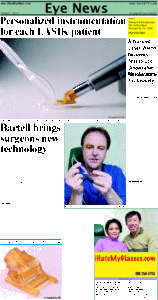Philadelphia / Bucks County LASIK Surgeon – Dr. James S. Lewis
Eye News Volume II Issue 2

State-of-the-art LASIK comes to town
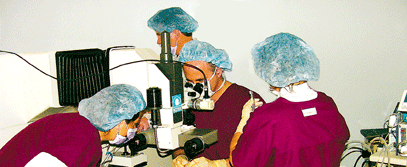
Sue Cross (LASIK coordinator and patient advocate, left) assists James Lewis, MD (center) during laser vision surgery. Dawn Cacia, RN (right) prepares the microkeratome and Robert Czajkowski (first assistant, background) runs the Nidek EC-5000 computer and excimer laser.
Established local eye surgeons dominate laser vision correction services
“Patients need to know their surgeon and the practice to whom they entrust their vision, “ claims James Lewis, MD. “By the time you add the cost of pre-operative evaluation, post-operative care, and enhancements patients lose time and money.”
He continues, “Patients reason that an eye surgeon who has thrived in the community for years can be trusted to provide top caliber LASIK care. These same surgeons are more likely to be available years later if needed.”
A professional, personable and caring staff is fundamental to success. “Patients need warm fuzzies”, says Sue Cross, head LASIK coordinator. “They are scared. They have only one set of eyes. You need to deserve and earn their trust.”
“I am very proud when a patient chooses us after visiting several LASIK providers”, Sue continues. “My job is to support the patient before surgery, during the procedure, and throughout visual rehabilitation.”
“Patients are smart. They can tell when you believe in the procedure, the surgical team and the doctor”, continues Sue Cross. “Dr. Lewis has performed over 4000 LASIK procedures, including most members of our staff. I would let him operate on me but I am already 20/15”.
He continues, “Patients reason that an eye surgeon who has thrived in the community for years can be trusted to provide top caliber LASIK care. These same surgeons are more likely to be available years later if needed.”
A professional, personable and caring staff is fundamental to success. “Patients need warm fuzzies”, says Sue Cross, head LASIK coordinator. “They are scared. They have only one set of eyes. You need to deserve and earn their trust.”
“I am very proud when a patient chooses us after visiting several LASIK providers”, Sue continues. “My job is to support the patient before surgery, during the procedure, and throughout visual rehabilitation.”
“Patients are smart. They can tell when you believe in the procedure, the surgical team and the doctor”, continues Sue Cross. “Dr. Lewis has performed over 4000 LASIK procedures, including most members of our staff. I would let him operate on me but I am already 20/15”.
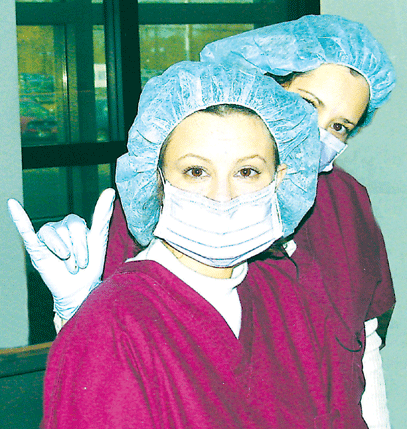
Dawn Cacia, RN and Sue Cross take their jobs seriously unless there is a photo opportunity.
Making sense of LASIK technology
“Broad beam lasers ignited the entire refractive surgery revolution”, says James Lewis, MD an experienced LASIK surgeon.
Broad beam lasers use an expanding circular beam to progressively remove tissue and reshape the cornea. The resulting ocular shape reduces or eliminates a patient’s need for glasses or contact lenses.
“We soon began to recognize flaws with this approach. Areas in the central cornea were not removed effectively and irregularities called central islands interfered with vision”, Lewis said. “We also realized broad beam lasers limited our range of treatment, caused excessive acoustic shock, and allowed vision threatening decentration…..As surgeons we wanted something better.” Lewis hasn’t used a broad beam laser in nearly two years.
“Outstanding optical engineers and laser physicists from the US, Japan, Germany, and Australia developed what we now considered modern excimer laser designs”, Lewis continues. “Flying spot lasers paint the cornea with small brushes. Scanning and flying slit lasers use different size rollers to ablate the cornea and reshape it.”
While some laser facilities have decided to simply upgrade or modify their broad beam lasers Lewis feels there is no future in that strategy. “New generation lasers permit more reliable results, faster rehabilitation, and a higher quality of visual function”, Lewis said.
Patients expect 20/20 vision. They also want to see well at night. Patients hope to experience less glare than they had with glasses and contact lenses. Modern excimer lasers may make this all possible.
“At first, I was intrigued by flying spot lasers. Unfortunately, in my view, they are not ready for prime time. Flying spot lasers take an extremely long time to treat the cornea allowing it to dry and warp during the process. Flying spot lasers also rely too heavily on eye movement tracking devices which can fail.” Lewis also claims, “these lasers are incredibly fragile and are still being refined”.
“Surgeons throughout the world have favored scanning and flying slit lasers. They are incredible capable, dependable and have a well-established track record.” Lewis claims.
Several of these advanced designs have been approved by the FDA. They are modular. “The Nidek EC-5000 has an elegant internal structure with sophisticated microprocessor control. The machine is made to grow as our knowledge of refractive surgery expands.”
As the Medical Director of Advanced Laser Vision, it is not surprising that Lewis selected NIDEK exclusively for all offices. He admits other respected surgeons in the region and elsewhere have followed suit.
“LASIK is great now and getting better every day”.
Broad beam lasers use an expanding circular beam to progressively remove tissue and reshape the cornea. The resulting ocular shape reduces or eliminates a patient’s need for glasses or contact lenses.
“We soon began to recognize flaws with this approach. Areas in the central cornea were not removed effectively and irregularities called central islands interfered with vision”, Lewis said. “We also realized broad beam lasers limited our range of treatment, caused excessive acoustic shock, and allowed vision threatening decentration…..As surgeons we wanted something better.” Lewis hasn’t used a broad beam laser in nearly two years.
“Outstanding optical engineers and laser physicists from the US, Japan, Germany, and Australia developed what we now considered modern excimer laser designs”, Lewis continues. “Flying spot lasers paint the cornea with small brushes. Scanning and flying slit lasers use different size rollers to ablate the cornea and reshape it.”
While some laser facilities have decided to simply upgrade or modify their broad beam lasers Lewis feels there is no future in that strategy. “New generation lasers permit more reliable results, faster rehabilitation, and a higher quality of visual function”, Lewis said.
Patients expect 20/20 vision. They also want to see well at night. Patients hope to experience less glare than they had with glasses and contact lenses. Modern excimer lasers may make this all possible.
“At first, I was intrigued by flying spot lasers. Unfortunately, in my view, they are not ready for prime time. Flying spot lasers take an extremely long time to treat the cornea allowing it to dry and warp during the process. Flying spot lasers also rely too heavily on eye movement tracking devices which can fail.” Lewis also claims, “these lasers are incredibly fragile and are still being refined”.
“Surgeons throughout the world have favored scanning and flying slit lasers. They are incredible capable, dependable and have a well-established track record.” Lewis claims.
Several of these advanced designs have been approved by the FDA. They are modular. “The Nidek EC-5000 has an elegant internal structure with sophisticated microprocessor control. The machine is made to grow as our knowledge of refractive surgery expands.”
As the Medical Director of Advanced Laser Vision, it is not surprising that Lewis selected NIDEK exclusively for all offices. He admits other respected surgeons in the region and elsewhere have followed suit.
“LASIK is great now and getting better every day”.
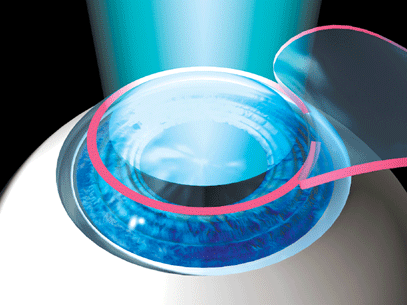
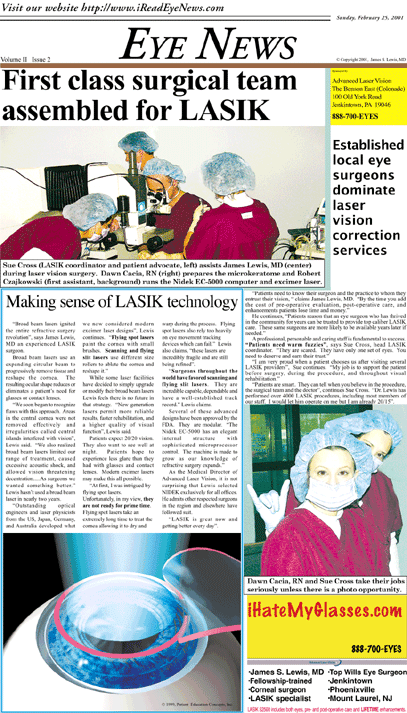
At Dr. Lewis’ state-of the art facilities, all patients are treated with the utmost attentiveness and dedication. This approach has helped Dr. Lewis establish a reputation as a leading Philadelphia, Bucks County, Elkins Park and Conshohocken LASIK and Epi-LASIK expert. In addition to performing laser eye surgery, Dr. Lewis also treats Philadelphia and Bucks County ICL patients.

